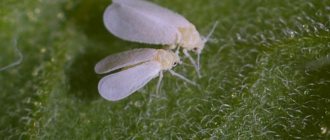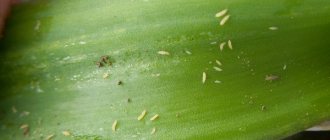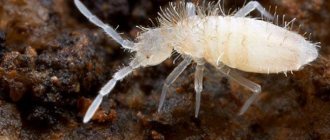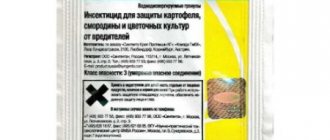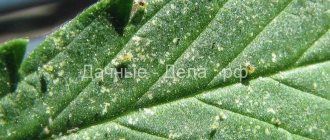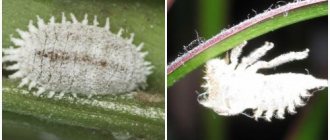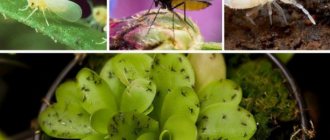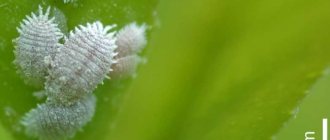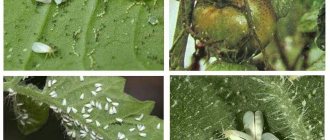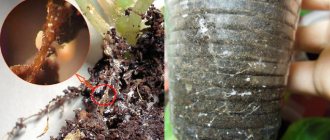Not everyone will be able to immediately recognize a formidable pest in a small insect, because the whitefly looks like an aphid. The body is up to 2 mm long and has wings, thanks to which the midge successfully flies from one plant to another. The insect has a detrimental effect on many types of garden crops, including vegetable seedlings and even indoor flowers, such as fuchsia, petunia, rose, geranium, pelargonium and others.
Adult whiteflies, as well as larvae, feed on plant sap, sucking it from the leaves and trunk. The nutritional metabolism of cells is disrupted and the plant, lacking nutrients, begins to wither. If you don’t start fighting the pest in time, you can say goodbye to the bush. Another problem is sooty fungus, which develops on the excrement of larvae and adult midges. Because of it, brown spots appear on the leaves, which can be used to suspect a problem. After all, the midges themselves are not visible at first during a quick inspection of the plants. They are located on the inside of the leaves. Eggs are laid there, from which the larva emerges after 20 days. The larva looks like a small dark dot.
Appearance of insects
Whiteflies are very small, even tiny butterflies that resemble house moths. The length of the largest individual does not exceed 4 mm. They got their name because of their snow-white wings, as if sprinkled with starch. It's actually a wax coating.
The body is painted pale yellow and is also covered with a waxy coating. The head has long antennae and compound eyes.
The eggs are microscopic in size , practically invisible, their length is only 0.1-0.2 mm . They are attached to the plant using a stem.
The larvae do not have wings ; they have a flat oval body, reaching 0.8-0.9 mm in length. The skin, which is initially transparent, becomes covered with a white waxy coating with age.
Next you will see a photo of whiteflies on indoor flowers:
Types of whiteflies on indoor plants
Not all known species of whiteflies can harm indoor plants. Most often, the following varieties live in houses:
- Greenhouse (greenhouse) whitefly . A very heat-loving species from the tropics, which can only live in greenhouses and houses .
- Cotton (tobacco) whitefly . An almost omnivorous pest, it loves humid heat. In such conditions, it can give birth to up to 14-16 generations per year .
- Giant whitefly . A real scourge of ornamental plants. The larvae differ from other species by the presence of long stripes of wax on them.
- Citrus whitefly . Prefers to feed on citrus plants, can harm gardenias , cherry laurel , hibiscus and ficus .
How to recognize the presence of a pest
The structure of the oral apparatus of this insect is a thin chitinous proboscis , with which it pierces the leaf blades and sucks the juice from them. It is in the wake of this vigorous activity that it becomes noticeable that vegetable plants are being precipitated by whiteflies.
Externally, signs of damage look like this:
- the leaf plate of greenhouse crops is covered with yellowish dots less than a millimeter in diameter;
- gradually there are more dots, the leaf begins to fade;
- on the reverse side of the leaf blades you can see a sooty coating;
- On healthy leaves, clutches of yellowish small (up to 0.25 mm in length) eggs laid out in circles are found.
If there are a lot of insects, the surface of the leaves is literally covered with the products of their vital activity - honeydew, which is the excrement of whitefly aphids. It becomes a kind of soil for fungi.
That is why the lack of insect control can lead not only to weakening of crops, but also to massive damage to vegetable plants by fungal infections.
Folk remedies
Washing leaves with water
The transformation of larvae into adult insects occurs in 7 days. Until this moment, they, being on the underside of the leaf, actively suck the juices out of it. In order to reduce the number of pests, it is necessary to destroy as many larvae as possible. Therefore, once a week it is necessary to thoroughly wipe each leaf with a moistened soft sponge. It is recommended to apply a soapy solution for this. Try to remove any existing larvae from the leaves. After some time, the pests will be completely destroyed.
However, this method is applicable only in the case of not a very large amount of vegetation. So, for example, in large plantings, greenhouses, greenhouses, this method is ineffective and labor-intensive.
Decrease in air temperature to 10 degrees
If the temperature is lowered to 10 degrees or less, then the adults die, but a certain number of larvae and eggs remain alive and simply hibernate. After the temperature increases by more than 15 degrees, they come to life and continue their normal life activities.
Other folk remedies are various solutions that should either be watered or sprayed on the affected plant.
Tinctures and solutions against whiteflies
Soap solution
To prepare the solution, laundry or tar soap is suitable. It should be crushed using a grater. Dissolve soap in water in a ratio of 1:6. The resulting liquid must be thoroughly beaten to form a stable foam, and then, using a sponge, apply it to the surface of the plant. The green parts of the plant can simply be sprayed with the resulting solution; there is no need to whisk it. The surface layer of soil also needs to be lightly sprayed.
In some cases, all insects will be destroyed after the first treatment. However, in most cases a new treatment will be required after 7 days.
Garlic infusion
For a liter of clean water you will need 2 medium-sized crushed garlic cloves (6 grams). Mix everything, cover and put the container in a dark place. After 24 hours, the infusion is filtered and used for spraying. As a rule, 2 or 3 treatments are enough, with a break of 1 week between them.
Infusion of yarrow herb
For a liter of water you will need about 90 grams of yarrow leaves (not dried). Mix and leave for 48 hours. Then the infusion needs to be filtered and the plant can be treated with it using a sprayer. 2 or 3 treatments are enough, the break is 1 week.
Tobacco infusion
To prepare the infusion, you need to purchase cigarettes (for example, “Prima”). Gut the tobacco from the cigarettes and pour a liter of not very hot water into it. Place the mixture in a dark place, and after 5 days the infusion will be ready for use. It needs to be filtered and used for spraying. Treatment is carried out once every three days until the whiteflies completely disappear.
Dandelion infusion
To prepare, you will need 40 grams of dandelion leaves and the same amount of roots of this plant. They are finely chopped and then mixed with a liter of water. After 3 or 4 days, the infusion will be ready. After filtering, it is used to spray plants. The treatment is repeated a couple of times, with an interval between them of a week.
HOW TO FIGHT WHITEFLY, WITHOUT CHEMICALS!!!!!!! IN A GREENHOUSE, WITH AVAILABLE MEANS, A SIMPLE METHOD
Reasons for appearance
Butterflies by themselves are unlikely to enter your home. They can be introduced along with the soil, a new plant, or on clothing.
Very rarely, whiteflies fly in on their own through open windows or vents.
In order for a butterfly to begin to reproduce, it requires certain conditions.
In cool rooms with a constant supply of fresh air, whiteflies most likely simply will not survive.
IMPORTANT! The ideal factors for development are heat, high humidity and stale air without the slightest movement. If the plants are arranged very closely together, tightly touching each other, it means that the whiteflies have found themselves in the most suitable conditions for life.
- What indoor plants can be affected by whiteflies?
Pests prefer succulent indoor flowers. Among the favorites are fuchsia , myrtle , pelargonium (geranium) , ficus , gloxinia , eucalyptus , calla lilies , impatiens , ferns . In general, any plants with fairly soft leaf blades.
Butterflies do not attack cacti and poisonous flowers.
Harm from parasites
Damage is caused by all stages of butterfly development, except eggs . The larva feeds on plant sap, weakening them. Such flowers stop developing and begin to wither and dry out.
Adults do not feed on sap, but they pollute plants with their excrement, which are subsequently attacked by sooty fungus.
It causes the affected parts to turn black and rot. In addition, whiteflies carry dangerous viruses that cannot be treated. First of all, these are chlorosis , viral mosaics , jaundice and leaf curl .
ATTENTION! Sick plants infected with viruses are the easiest to dispose of.
Other effective drugs
Spark
An insecticide identical in action to Aktara. Valid for 25 days.
Confidor and its analogues
Not only kills the main colony after watering, but also has a contact effect (only against adult insects).
Akarin
Contact and food poison for whiteflies. You should not relax immediately after treatment - you need to monitor the plant for some more time to make sure that the whitefly has died as a whole in the colony. Relapses often occur, to which it is worth responding just as quickly.
Preventive measures
To avoid introducing these harmful insects into your home, you should take some precautions.
- The brought soil can be disinfected - pour boiling water on it, steam it in the microwave or oven, and treat it with strong potassium permanganate. This will help destroy eggs and larvae if present.
- New plants must be placed separately , “quarantined”, to exclude the possibility of infection of other flowers.
- important to constantly ventilate the rooms in which indoor plants are located , giving access to fresh air.
- Regularly conduct a visual inspection of existing flowers in order to detect infection in the early stages and react immediately, without waiting for active reproduction of insects.
These simple steps can save your plants from death.
Fighting methods
REFERENCE! The most difficult thing to destroy is the last generation of larvae, which are covered with a dense wax shell. For maximum effectiveness, it is recommended to combine several methods.
Physical method
Use of mechanical traps. In this manner, you can only get rid of adult individuals that can fly.
- Small plywood or pieces of cardboard should be painted a bright color - white or yellow - to attract the attention of whiteflies.
- Then spread with castor oil, Vaseline or a mixture of honey and rosin.
- Place near affected plants.
You can use sticky fly strips.
Chemical method
The most effective and fastest, based on the use of chemical insecticides. The following drugs work well against whiteflies:
To destroy all stages of whiteflies, it should be treated at least 2 times. Wait 6-8 days between operations. We talked in detail about all the remedies that will help get rid of whiteflies at home, as well as how to properly prepare and use these preparations, in a separate article.
IMPORTANT! It is advisable to use different insecticides so that insects do not become addicted.
We talked in more detail about how to get rid of whiteflies on indoor plants in this article, and here you will learn about methods of combating this insect on the site and in the greenhouse.
Processing rules
Depending on the substance, one of the treatment methods is selected - watering or spraying. Most insecticides work in the first way - in order to saturate the plant and kill numerous larvae, folk remedies, on the contrary, usually require spraying.
Often these measures intersect with each other in a variety of processing methods. Experienced gardeners advise not to neglect spraying in any case.
Whitefly on fuchsia
Harmful butterflies are very fond of delicate fuchsia. To avoid losing the plant, measures should be taken immediately. First of all, you need to take the flower to a cool room where the temperature does not rise above 14-16° . Fuchsia can easily withstand regime changes, unlike heat-loving whiteflies.
To consolidate the result and finally survive the pests, place a trap next to the pot and treat the flower with insecticides.
Whiteflies are flying pests that can cause serious damage to plants. However, they can be dealt with quite well. And the sooner you start the fight, the greater the chances of a good result.
And if you have whiteflies on your indoor plants, the video will tell you how to fight them. Enjoy watching!
Prevention measures
You won’t be able to completely protect your flowers from the possible appearance of whiteflies - but you can do everything possible. The best thing you can do to keep your houseplants safe is to install mosquito nets.
IMPORTANT! It is highly likely that you will get whiteflies if you grow tomatoes at home - these pests love them very much. Try to keep such seedlings away from flowers.
It is not worth treating plants with chemicals prophylactically - this can be harmful. Try to inspect the flowers more often. As soon as you notice several individuals, be sure to kill them - this way you can prevent the emergence of a colony.
